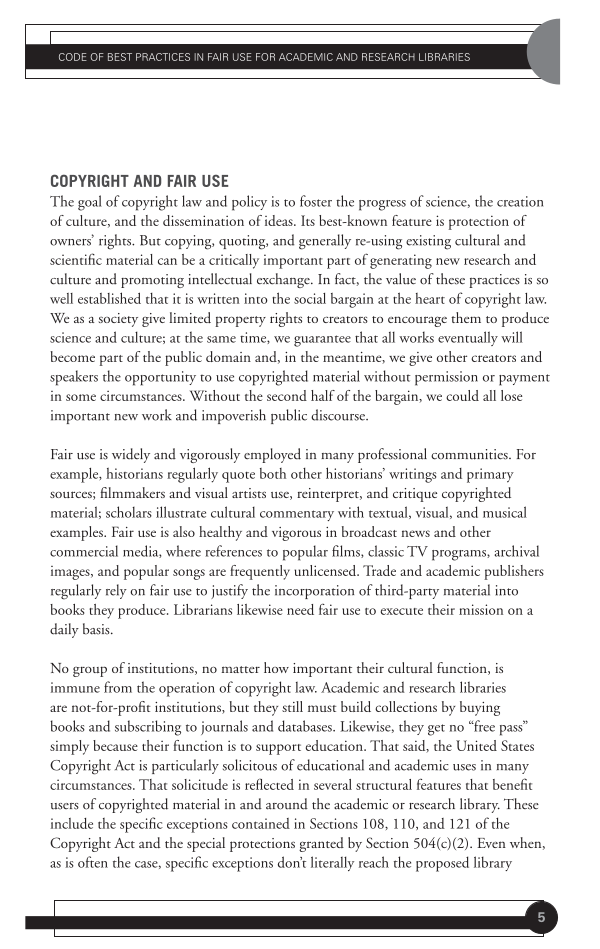CODE OF BEST PRACTICES IN FAIR USE FOR ACADEMIC AND RESEARCH LIBRARIES
5
COPYRIGHT AND FAIR USE
The goal of copyright law and policy is to foster the progress of science, the creation
of culture, and the dissemination of ideas. Its best-known feature is protection of
owners’ rights. But copying, quoting, and generally re-using existing cultural and
scientific material can be a critically important part of generating new research and
culture and promoting intellectual exchange. In fact, the value of these practices is so
well established that it is written into the social bargain at the heart of copyright law.
We as a society give limited property rights to creators to encourage them to produce
science and culture at the same time, we guarantee that all works eventually will
become part of the public domain and, in the meantime, we give other creators and
speakers the opportunity to use copyrighted material without permission or payment
in some circumstances. Without the second half of the bargain, we could all lose
important new work and impoverish public discourse.
Fair use is widely and vigorously employed in many professional communities. For
example, historians regularly quote both other historians’ writings and primary
sources filmmakers and visual artists use, reinterpret, and critique copyrighted
material scholars illustrate cultural commentary with textual, visual, and musical
examples. Fair use is also healthy and vigorous in broadcast news and other
commercial media, where references to popular films, classic TV programs, archival
images, and popular songs are frequently unlicensed. Trade and academic publishers
regularly rely on fair use to justify the incorporation of third-party material into
books they produce. Librarians likewise need fair use to execute their mission on a
daily basis.
No group of institutions, no matter how important their cultural function, is
immune from the operation of copyright law. Academic and research libraries
are not-for-profit institutions, but they still must build collections by buying
books and subscribing to journals and databases. Likewise, they get no “free pass”
simply because their function is to support education. That said, the United States
Copyright Act is particularly solicitous of educational and academic uses in many
circumstances. That solicitude is reflected in several structural features that benefit
users of copyrighted material in and around the academic or research library. These
include the specific exceptions contained in Sections 108, 110, and 121 of the
Copyright Act and the special protections granted by Section 504(c)(2). Even when,
as is often the case, specific exceptions don’t literally reach the proposed library
5
COPYRIGHT AND FAIR USE
The goal of copyright law and policy is to foster the progress of science, the creation
of culture, and the dissemination of ideas. Its best-known feature is protection of
owners’ rights. But copying, quoting, and generally re-using existing cultural and
scientific material can be a critically important part of generating new research and
culture and promoting intellectual exchange. In fact, the value of these practices is so
well established that it is written into the social bargain at the heart of copyright law.
We as a society give limited property rights to creators to encourage them to produce
science and culture at the same time, we guarantee that all works eventually will
become part of the public domain and, in the meantime, we give other creators and
speakers the opportunity to use copyrighted material without permission or payment
in some circumstances. Without the second half of the bargain, we could all lose
important new work and impoverish public discourse.
Fair use is widely and vigorously employed in many professional communities. For
example, historians regularly quote both other historians’ writings and primary
sources filmmakers and visual artists use, reinterpret, and critique copyrighted
material scholars illustrate cultural commentary with textual, visual, and musical
examples. Fair use is also healthy and vigorous in broadcast news and other
commercial media, where references to popular films, classic TV programs, archival
images, and popular songs are frequently unlicensed. Trade and academic publishers
regularly rely on fair use to justify the incorporation of third-party material into
books they produce. Librarians likewise need fair use to execute their mission on a
daily basis.
No group of institutions, no matter how important their cultural function, is
immune from the operation of copyright law. Academic and research libraries
are not-for-profit institutions, but they still must build collections by buying
books and subscribing to journals and databases. Likewise, they get no “free pass”
simply because their function is to support education. That said, the United States
Copyright Act is particularly solicitous of educational and academic uses in many
circumstances. That solicitude is reflected in several structural features that benefit
users of copyrighted material in and around the academic or research library. These
include the specific exceptions contained in Sections 108, 110, and 121 of the
Copyright Act and the special protections granted by Section 504(c)(2). Even when,
as is often the case, specific exceptions don’t literally reach the proposed library


































